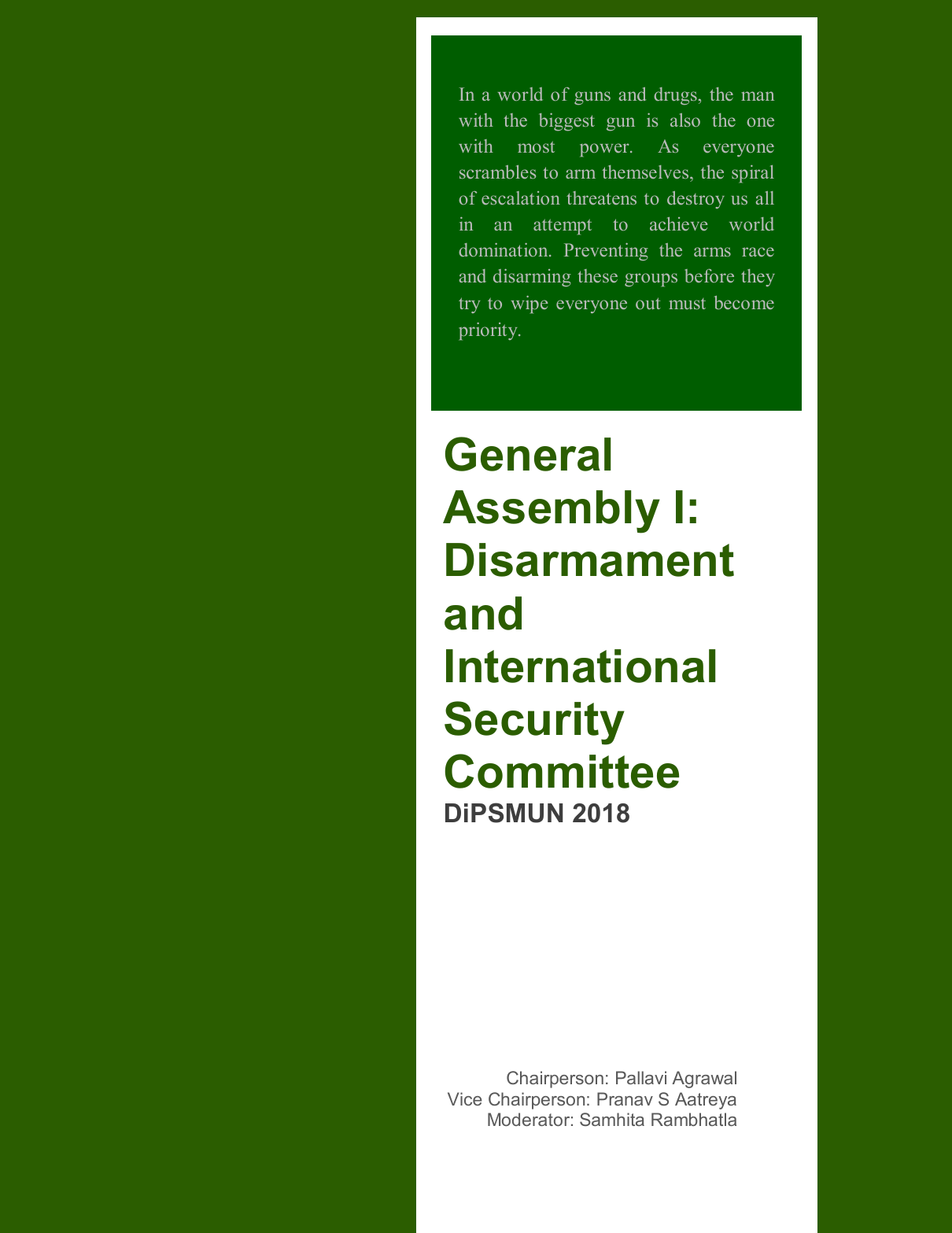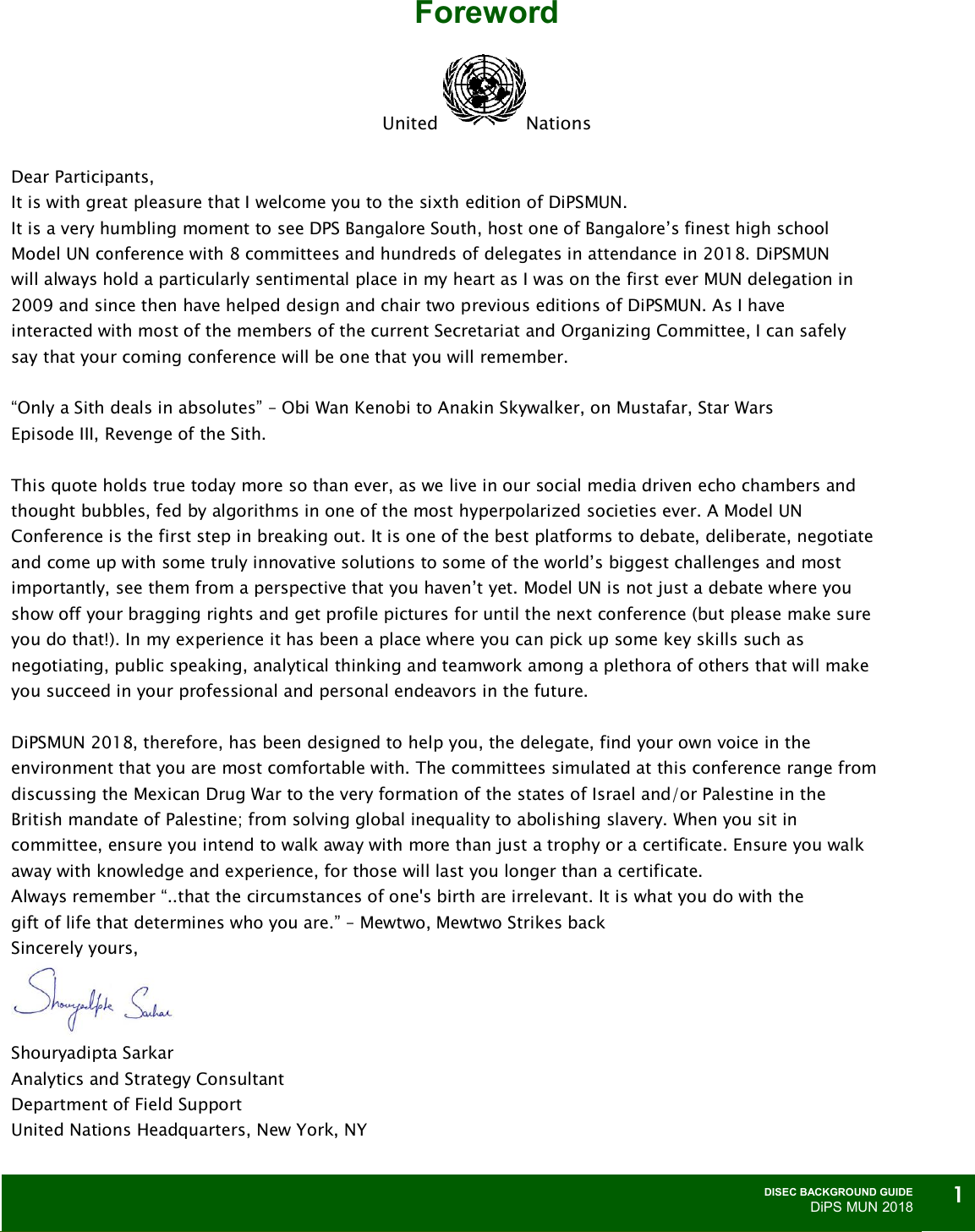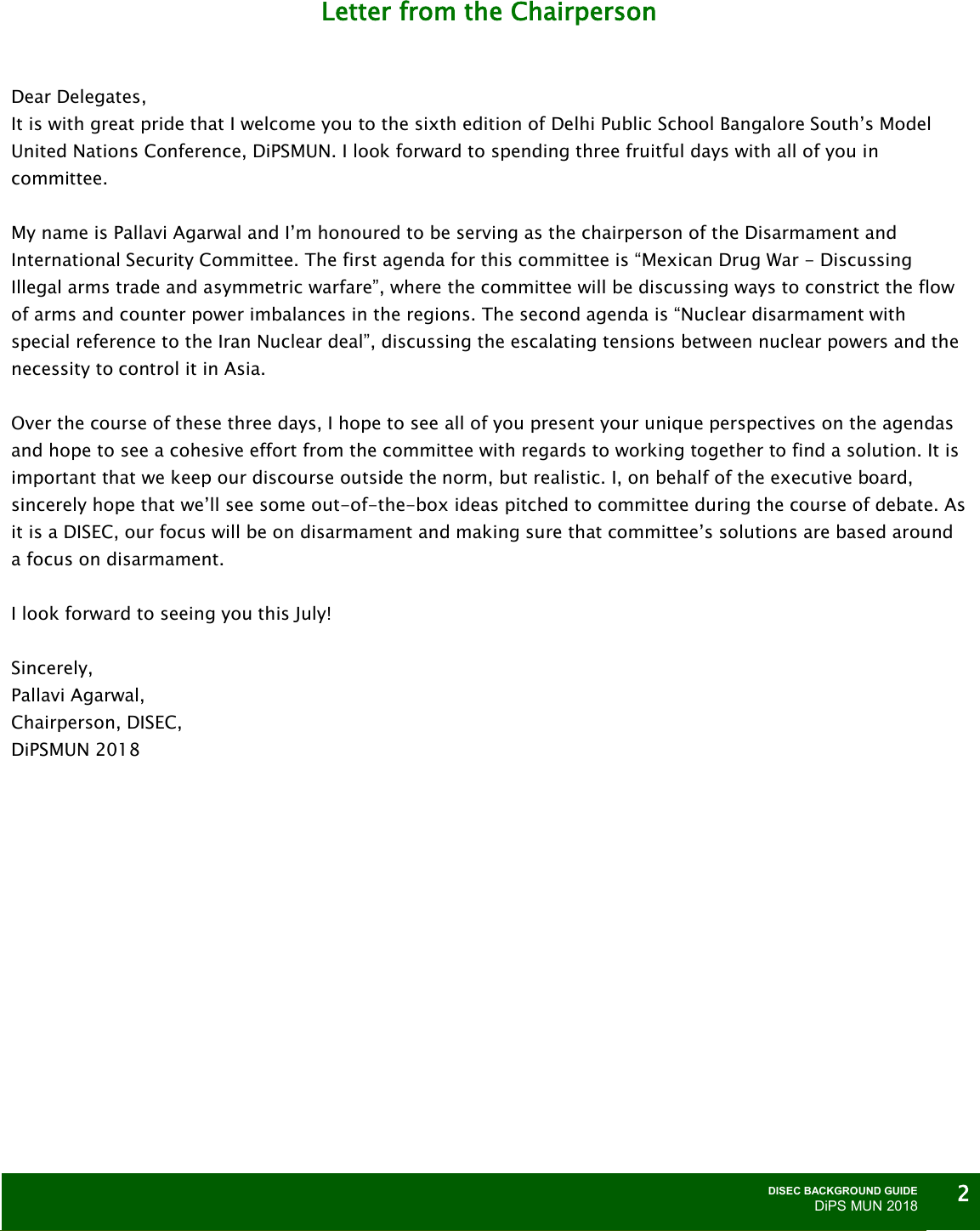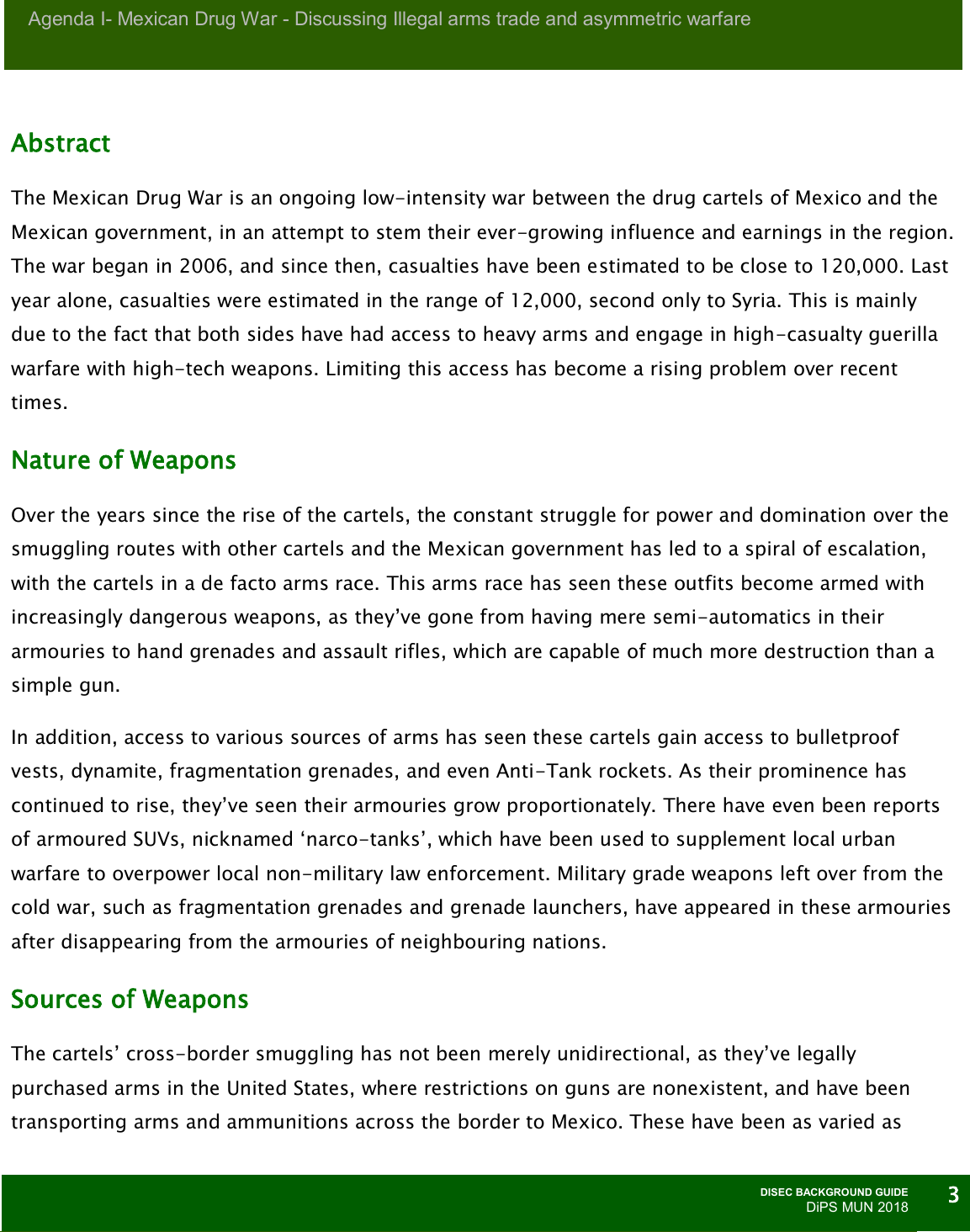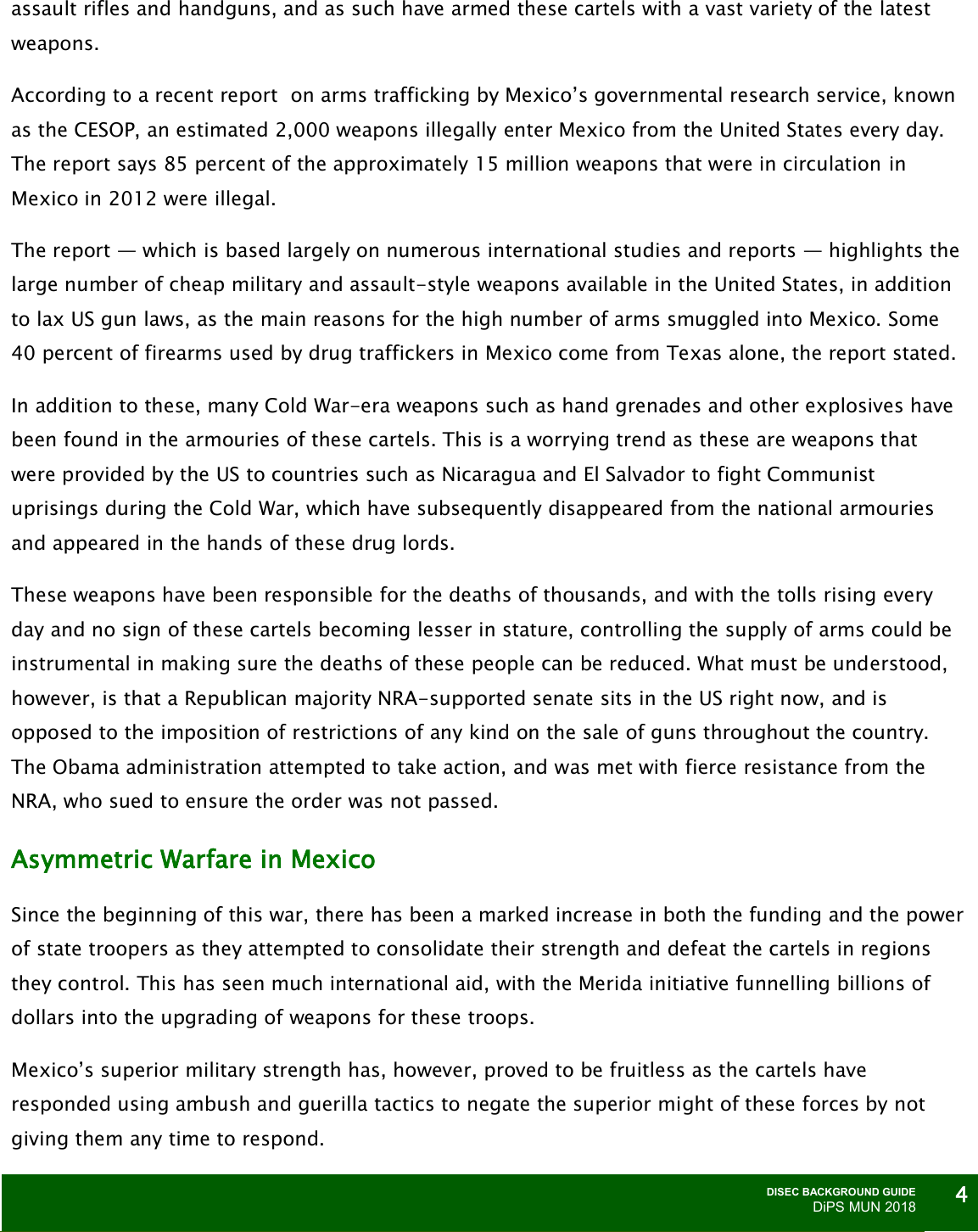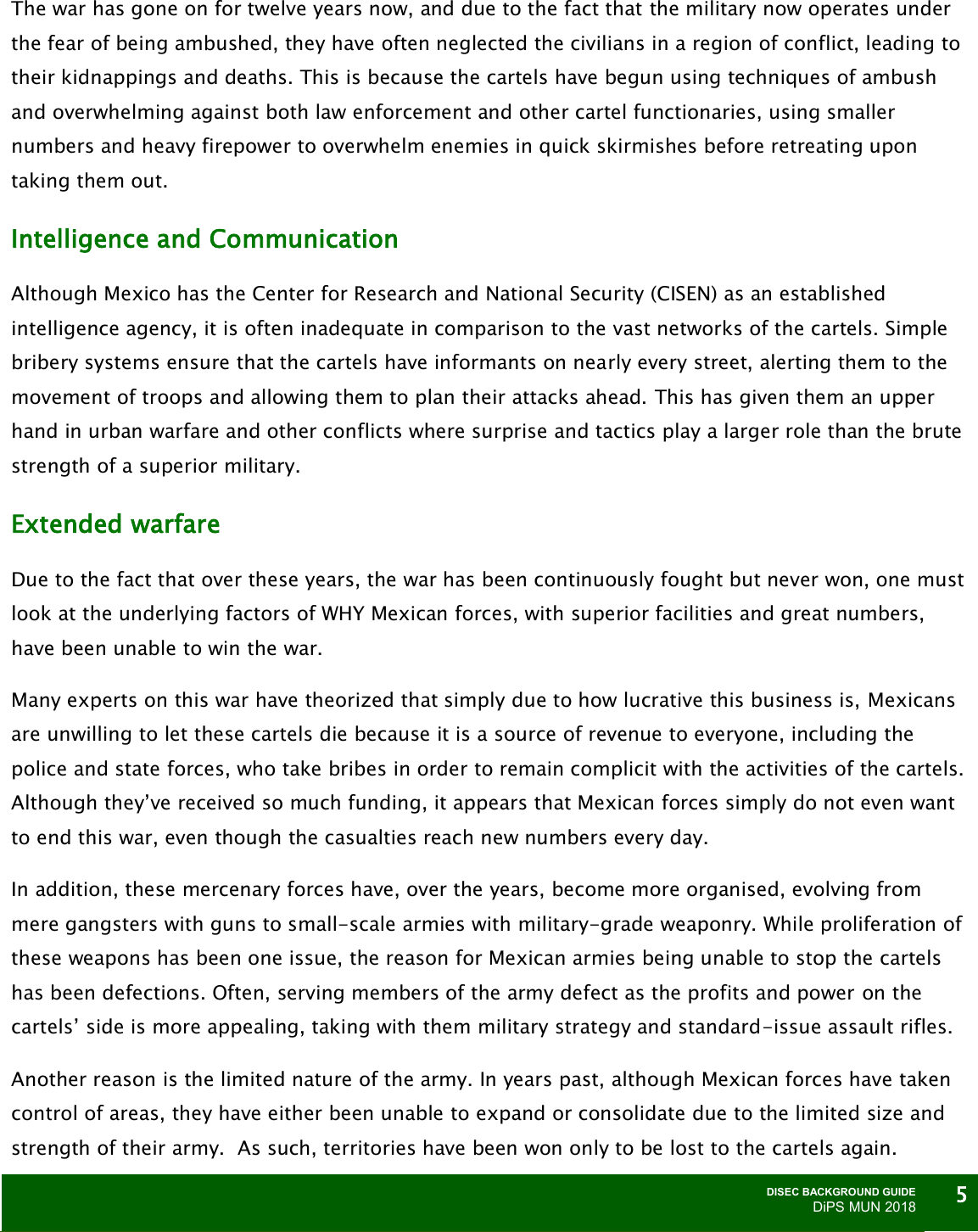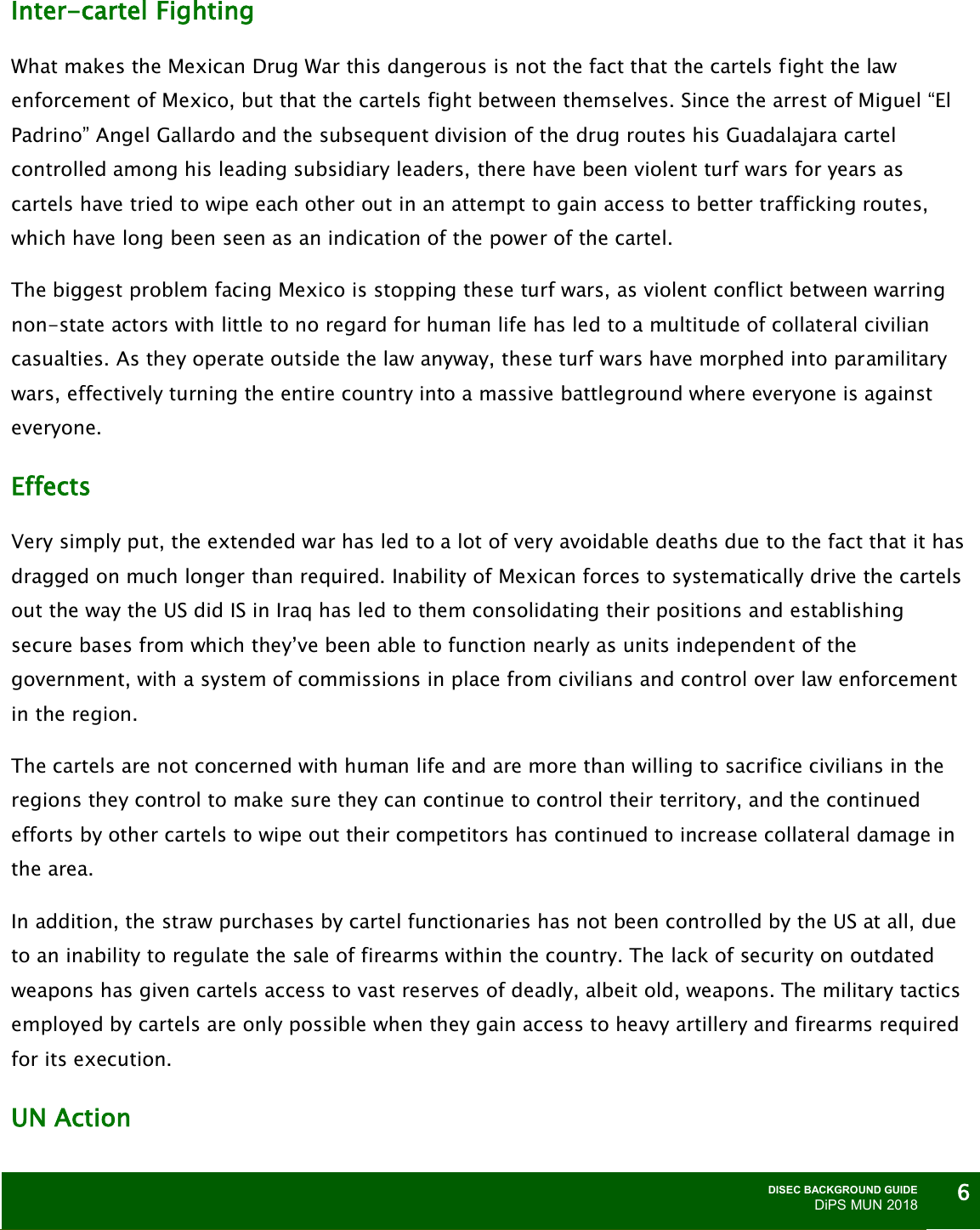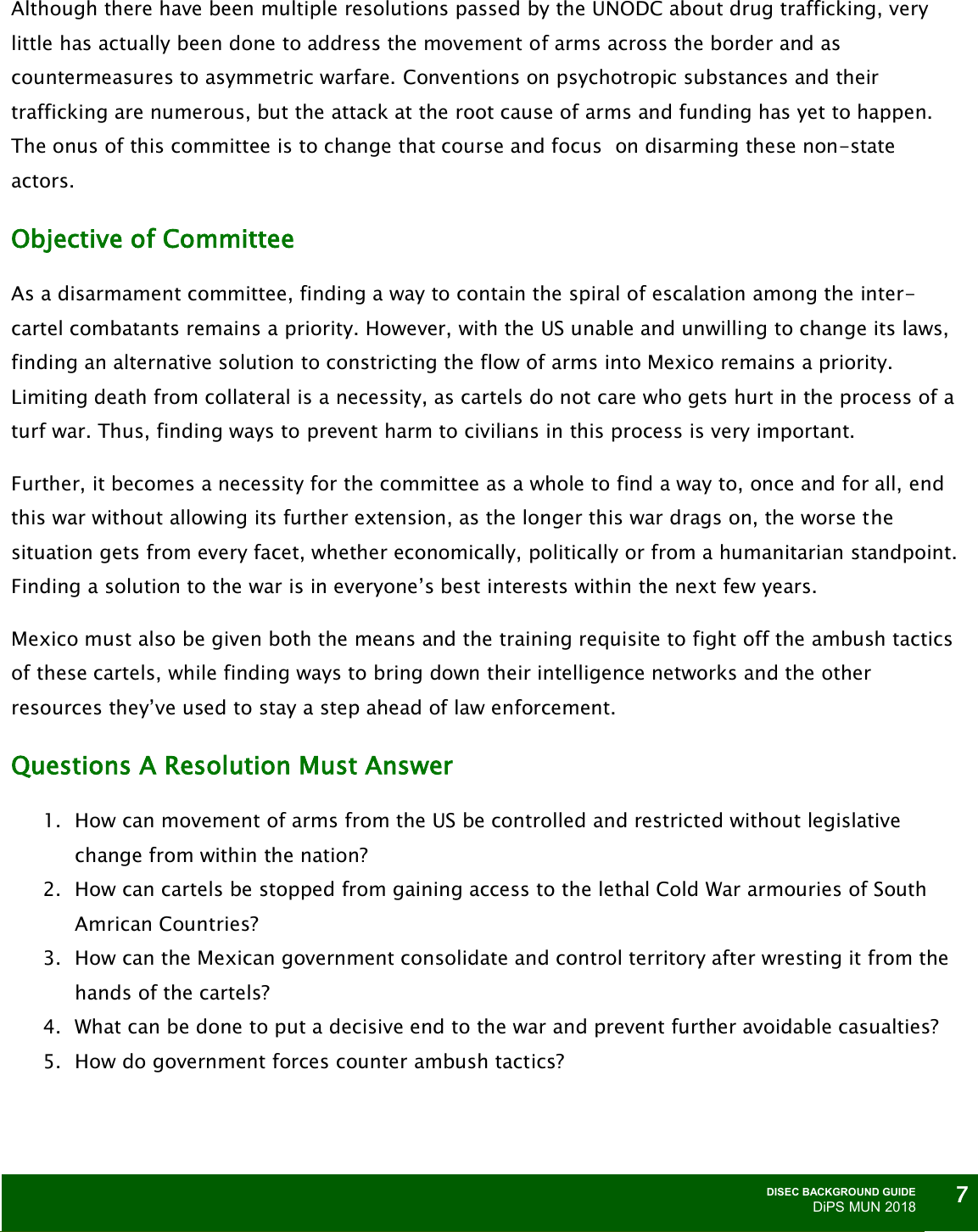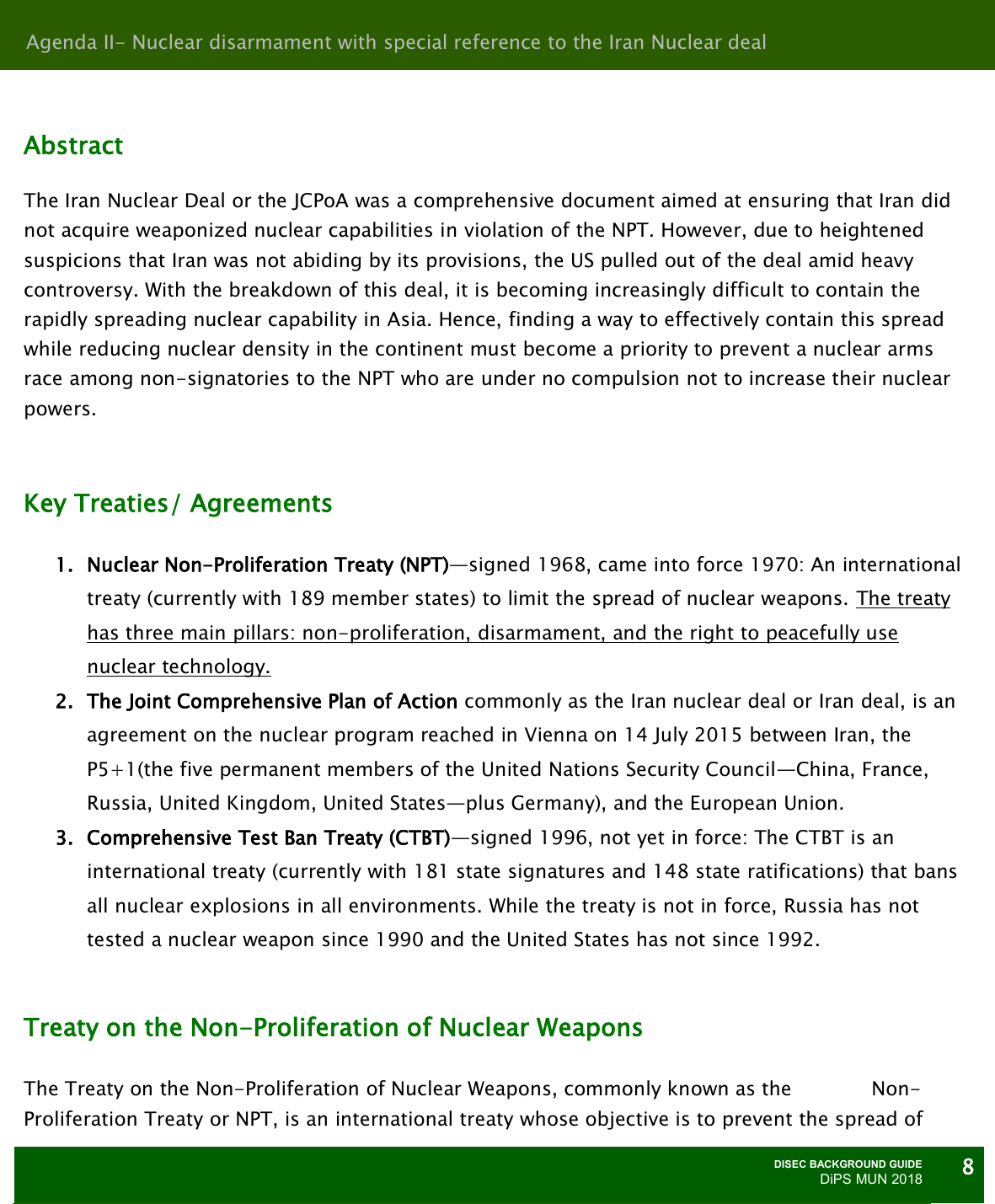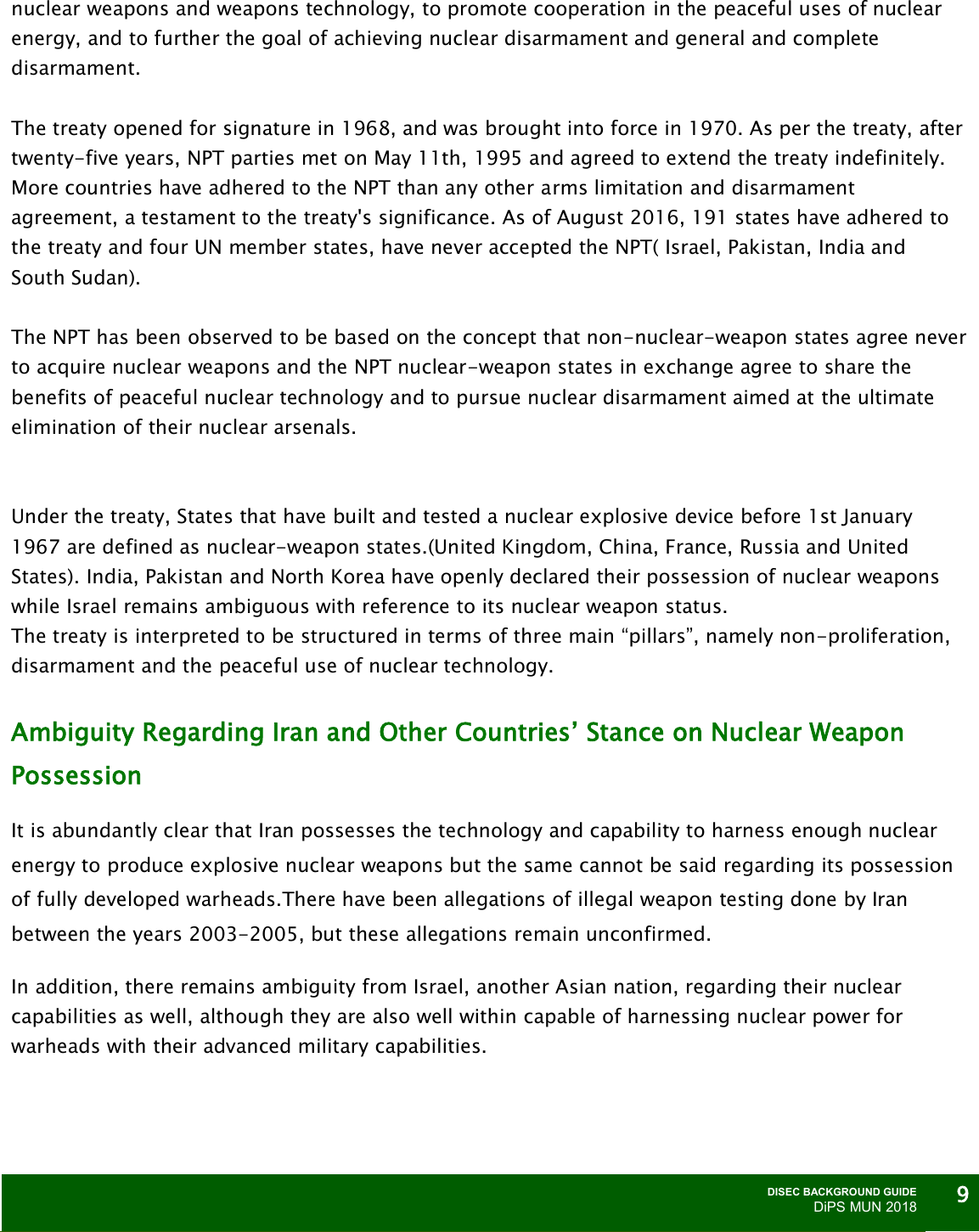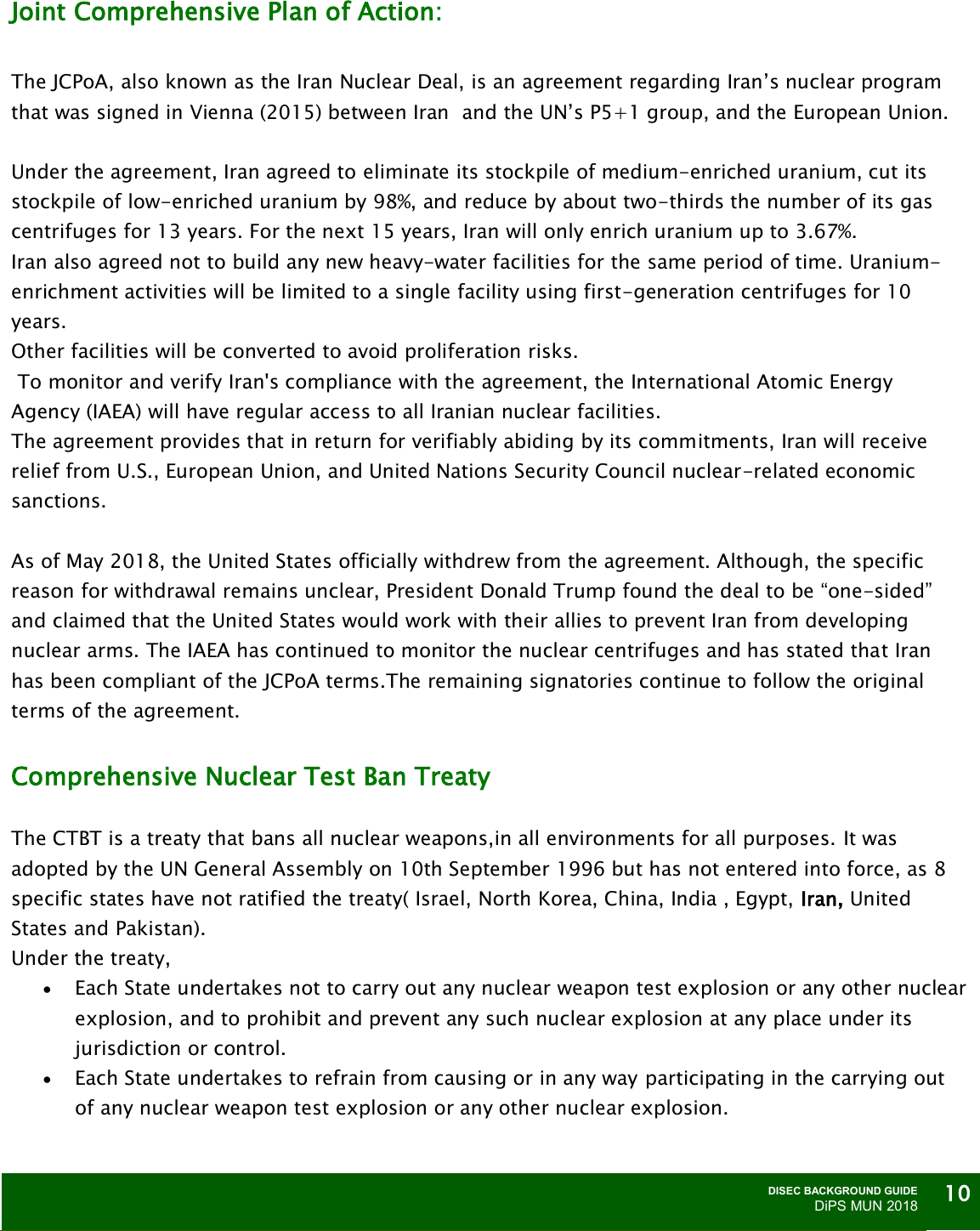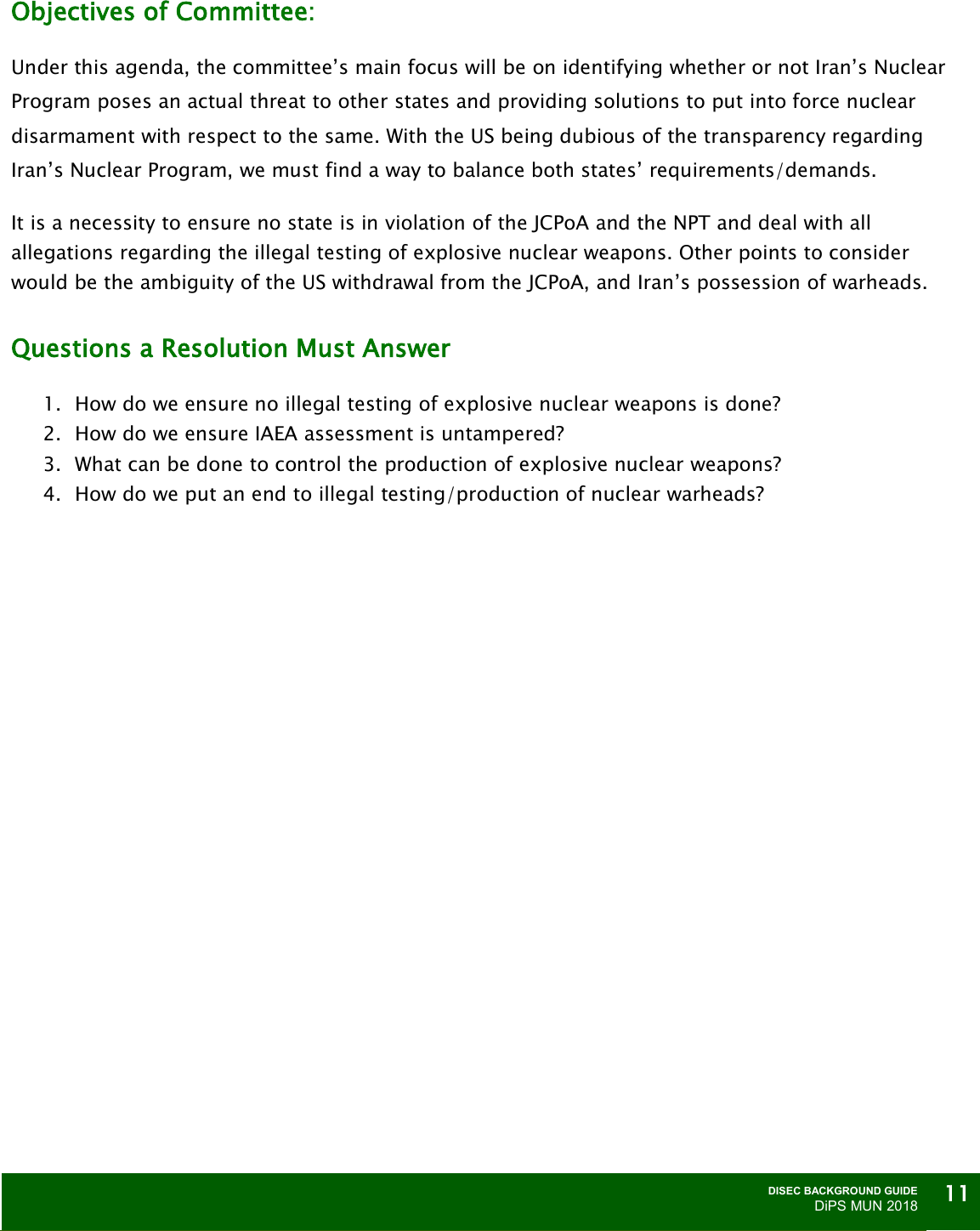2610b432 3fcc 4013 9c19 Dfc68d59f754 DISEC Background Guide
User Manual:
Open the PDF directly: View PDF ![]() .
.
Page Count: 12

In a world of guns and drugs, the man
with the biggest gun is also the one
with most power. As everyone
scrambles to arm themselves, the spiral
of escalation threatens to destroy us all
in an attempt to achieve world
domination. Preventing the arms race
and disarming these groups before they
try to wipe everyone out must become
priority.
General
Assembly I:
Disarmament
and
International
Security
Committee
DiPSMUN 2018
Chairperson: Pallavi Agrawal
Vice Chairperson: Pranav S Aatreya
Moderator: Samhita Rambhatla

DISEC BACKGROUND GUIDE
DiPS MUN 2018
1
Foreword
United Nations
Dear Participants,
It is with great pleasure that I welcome you to the sixth edition of DiPSMUN.
It is a very humbling moment to see DPS Bangalore South, host one of Bangalore’s finest high school
Model UN conference with 8 committees and hundreds of delegates in attendance in 2018. DiPSMUN
will always hold a particularly sentimental place in my heart as I was on the first ever MUN delegation in
2009 and since then have helped design and chair two previous editions of DiPSMUN. As I have
interacted with most of the members of the current Secretariat and Organizing Committee, I can safely
say that your coming conference will be one that you will remember.
“Only a Sith deals in absolutes” – Obi Wan Kenobi to Anakin Skywalker, on Mustafar, Star Wars
Episode III, Revenge of the Sith.
This quote holds true today more so than ever, as we live in our social media driven echo chambers and
thought bubbles, fed by algorithms in one of the most hyperpolarized societies ever. A Model UN
Conference is the first step in breaking out. It is one of the best platforms to debate, deliberate, negotiate
and come up with some truly innovative solutions to some of the world’s biggest challenges and most
importantly, see them from a perspective that you haven’t yet. Model UN is not just a debate where you
show off your bragging rights and get profile pictures for until the next conference (but please make sure
you do that!). In my experience it has been a place where you can pick up some key skills such as
negotiating, public speaking, analytical thinking and teamwork among a plethora of others that will make
you succeed in your professional and personal endeavors in the future.
DiPSMUN 2018, therefore, has been designed to help you, the delegate, find your own voice in the
environment that you are most comfortable with. The committees simulated at this conference range from
discussing the Mexican Drug War to the very formation of the states of Israel and/or Palestine in the
British mandate of Palestine; from solving global inequality to abolishing slavery. When you sit in
committee, ensure you intend to walk away with more than just a trophy or a certificate. Ensure you walk
away with knowledge and experience, for those will last you longer than a certificate.
Always remember “..that the circumstances of one's birth are irrelevant. It is what you do with the
gift of life that determines who you are.” – Mewtwo, Mewtwo Strikes back
Sincerely yours,
Shouryadipta Sarkar
Analytics and Strategy Consultant
Department of Field Support
United Nations Headquarters, New York, NY

DISEC BACKGROUND GUIDE
DiPS MUN 2018
2
Letter from the Chairperson
Dear Delegates,
It is with great pride that I welcome you to the sixth edition of Delhi Public School Bangalore South’s Model
United Nations Conference, DiPSMUN. I look forward to spending three fruitful days with all of you in
committee.
My name is Pallavi Agarwal and I’m honoured to be serving as the chairperson of the Disarmament and
International Security Committee. The first agenda for this committee is “Mexican Drug War - Discussing
Illegal arms trade and asymmetric warfare”, where the committee will be discussing ways to constrict the flow
of arms and counter power imbalances in the regions. The second agenda is “Nuclear disarmament with
special reference to the Iran Nuclear deal”, discussing the escalating tensions between nuclear powers and the
necessity to control it in Asia.
Over the course of these three days, I hope to see all of you present your unique perspectives on the agendas
and hope to see a cohesive effort from the committee with regards to working together to find a solution. It is
important that we keep our discourse outside the norm, but realistic. I, on behalf of the executive board,
sincerely hope that we’ll see some out-of-the-box ideas pitched to committee during the course of debate. As
it is a DISEC, our focus will be on disarmament and making sure that committee’s solutions are based around
a focus on disarmament.
I look forward to seeing you this July!
Sincerely,
Pallavi Agarwal,
Chairperson, DISEC,
DiPSMUN 2018

DISEC BACKGROUND GUIDE
DiPS MUN 2018
3
Abstract
The Mexican Drug War is an ongoing low-intensity war between the drug cartels of Mexico and the
Mexican government, in an attempt to stem their ever-growing influence and earnings in the region.
The war began in 2006, and since then, casualties have been estimated to be close to 120,000. Last
year alone, casualties were estimated in the range of 12,000, second only to Syria. This is mainly
due to the fact that both sides have had access to heavy arms and engage in high-casualty guerilla
warfare with high-tech weapons. Limiting this access has become a rising problem over recent
times.
Nature of Weapons
Over the years since the rise of the cartels, the constant struggle for power and domination over the
smuggling routes with other cartels and the Mexican government has led to a spiral of escalation,
with the cartels in a de facto arms race. This arms race has seen these outfits become armed with
increasingly dangerous weapons, as they’ve gone from having mere semi-automatics in their
armouries to hand grenades and assault rifles, which are capable of much more destruction than a
simple gun.
In addition, access to various sources of arms has seen these cartels gain access to bulletproof
vests, dynamite, fragmentation grenades, and even Anti-Tank rockets. As their prominence has
continued to rise, they’ve seen their armouries grow proportionately. There have even been reports
of armoured SUVs, nicknamed ‘narco-tanks’, which have been used to supplement local urban
warfare to overpower local non-military law enforcement. Military grade weapons left over from the
cold war, such as fragmentation grenades and grenade launchers, have appeared in these armouries
after disappearing from the armouries of neighbouring nations.
Sources of Weapons
The cartels’ cross-border smuggling has not been merely unidirectional, as they’ve legally
purchased arms in the United States, where restrictions on guns are nonexistent, and have been
transporting arms and ammunitions across the border to Mexico. These have been as varied as
Agenda I- Mexican Drug War - Discussing Illegal arms trade and asymmetric warfare

DISEC BACKGROUND GUIDE
DiPS MUN 2018
4
assault rifles and handguns, and as such have armed these cartels with a vast variety of the latest
weapons.
According to a recent report on arms trafficking by Mexico’s governmental research service, known
as the CESOP, an estimated 2,000 weapons illegally enter Mexico from the United States every day.
The report says 85 percent of the approximately 15 million weapons that were in circulation in
Mexico in 2012 were illegal.
The report — which is based largely on numerous international studies and reports — highlights the
large number of cheap military and assault-style weapons available in the United States, in addition
to lax US gun laws, as the main reasons for the high number of arms smuggled into Mexico. Some
40 percent of firearms used by drug traffickers in Mexico come from Texas alone, the report stated.
In addition to these, many Cold War-era weapons such as hand grenades and other explosives have
been found in the armouries of these cartels. This is a worrying trend as these are weapons that
were provided by the US to countries such as Nicaragua and El Salvador to fight Communist
uprisings during the Cold War, which have subsequently disappeared from the national armouries
and appeared in the hands of these drug lords.
These weapons have been responsible for the deaths of thousands, and with the tolls rising every
day and no sign of these cartels becoming lesser in stature, controlling the supply of arms could be
instrumental in making sure the deaths of these people can be reduced. What must be understood,
however, is that a Republican majority NRA-supported senate sits in the US right now, and is
opposed to the imposition of restrictions of any kind on the sale of guns throughout the country.
The Obama administration attempted to take action, and was met with fierce resistance from the
NRA, who sued to ensure the order was not passed.
Asymmetric Warfare in Mexico
Since the beginning of this war, there has been a marked increase in both the funding and the power
of state troopers as they attempted to consolidate their strength and defeat the cartels in regions
they control. This has seen much international aid, with the Merida initiative funnelling billions of
dollars into the upgrading of weapons for these troops.
Mexico’s superior military strength has, however, proved to be fruitless as the cartels have
responded using ambush and guerilla tactics to negate the superior might of these forces by not
giving them any time to respond.

DISEC BACKGROUND GUIDE
DiPS MUN 2018
5
The war has gone on for twelve years now, and due to the fact that the military now operates under
the fear of being ambushed, they have often neglected the civilians in a region of conflict, leading to
their kidnappings and deaths. This is because the cartels have begun using techniques of ambush
and overwhelming against both law enforcement and other cartel functionaries, using smaller
numbers and heavy firepower to overwhelm enemies in quick skirmishes before retreating upon
taking them out.
Intelligence and Communication
Although Mexico has the Center for Research and National Security (CISEN) as an established
intelligence agency, it is often inadequate in comparison to the vast networks of the cartels. Simple
bribery systems ensure that the cartels have informants on nearly every street, alerting them to the
movement of troops and allowing them to plan their attacks ahead. This has given them an upper
hand in urban warfare and other conflicts where surprise and tactics play a larger role than the brute
strength of a superior military.
Extended warfare
Due to the fact that over these years, the war has been continuously fought but never won, one must
look at the underlying factors of WHY Mexican forces, with superior facilities and great numbers,
have been unable to win the war.
Many experts on this war have theorized that simply due to how lucrative this business is, Mexicans
are unwilling to let these cartels die because it is a source of revenue to everyone, including the
police and state forces, who take bribes in order to remain complicit with the activities of the cartels.
Although they’ve received so much funding, it appears that Mexican forces simply do not even want
to end this war, even though the casualties reach new numbers every day.
In addition, these mercenary forces have, over the years, become more organised, evolving from
mere gangsters with guns to small-scale armies with military-grade weaponry. While proliferation of
these weapons has been one issue, the reason for Mexican armies being unable to stop the cartels
has been defections. Often, serving members of the army defect as the profits and power on the
cartels’ side is more appealing, taking with them military strategy and standard-issue assault rifles.
Another reason is the limited nature of the army. In years past, although Mexican forces have taken
control of areas, they have either been unable to expand or consolidate due to the limited size and
strength of their army. As such, territories have been won only to be lost to the cartels again.

DISEC BACKGROUND GUIDE
DiPS MUN 2018
6
Inter-cartel Fighting
What makes the Mexican Drug War this dangerous is not the fact that the cartels fight the law
enforcement of Mexico, but that the cartels fight between themselves. Since the arrest of Miguel “El
Padrino” Angel Gallardo and the subsequent division of the drug routes his Guadalajara cartel
controlled among his leading subsidiary leaders, there have been violent turf wars for years as
cartels have tried to wipe each other out in an attempt to gain access to better trafficking routes,
which have long been seen as an indication of the power of the cartel.
The biggest problem facing Mexico is stopping these turf wars, as violent conflict between warring
non-state actors with little to no regard for human life has led to a multitude of collateral civilian
casualties. As they operate outside the law anyway, these turf wars have morphed into paramilitary
wars, effectively turning the entire country into a massive battleground where everyone is against
everyone.
Effects
Very simply put, the extended war has led to a lot of very avoidable deaths due to the fact that it has
dragged on much longer than required. Inability of Mexican forces to systematically drive the cartels
out the way the US did IS in Iraq has led to them consolidating their positions and establishing
secure bases from which they’ve been able to function nearly as units independent of the
government, with a system of commissions in place from civilians and control over law enforcement
in the region.
The cartels are not concerned with human life and are more than willing to sacrifice civilians in the
regions they control to make sure they can continue to control their territory, and the continued
efforts by other cartels to wipe out their competitors has continued to increase collateral damage in
the area.
In addition, the straw purchases by cartel functionaries has not been controlled by the US at all, due
to an inability to regulate the sale of firearms within the country. The lack of security on outdated
weapons has given cartels access to vast reserves of deadly, albeit old, weapons. The military tactics
employed by cartels are only possible when they gain access to heavy artillery and firearms required
for its execution.
UN Action

DISEC BACKGROUND GUIDE
DiPS MUN 2018
7
Although there have been multiple resolutions passed by the UNODC about drug trafficking, very
little has actually been done to address the movement of arms across the border and as
countermeasures to asymmetric warfare. Conventions on psychotropic substances and their
trafficking are numerous, but the attack at the root cause of arms and funding has yet to happen.
The onus of this committee is to change that course and focus on disarming these non-state
actors.
Objective of Committee
As a disarmament committee, finding a way to contain the spiral of escalation among the inter-
cartel combatants remains a priority. However, with the US unable and unwilling to change its laws,
finding an alternative solution to constricting the flow of arms into Mexico remains a priority.
Limiting death from collateral is a necessity, as cartels do not care who gets hurt in the process of a
turf war. Thus, finding ways to prevent harm to civilians in this process is very important.
Further, it becomes a necessity for the committee as a whole to find a way to, once and for all, end
this war without allowing its further extension, as the longer this war drags on, the worse the
situation gets from every facet, whether economically, politically or from a humanitarian standpoint.
Finding a solution to the war is in everyone’s best interests within the next few years.
Mexico must also be given both the means and the training requisite to fight off the ambush tactics
of these cartels, while finding ways to bring down their intelligence networks and the other
resources they’ve used to stay a step ahead of law enforcement.
Questions A Resolution Must Answer
1. How can movement of arms from the US be controlled and restricted without legislative
change from within the nation?
2. How can cartels be stopped from gaining access to the lethal Cold War armouries of South
Amrican Countries?
3. How can the Mexican government consolidate and control territory after wresting it from the
hands of the cartels?
4. What can be done to put a decisive end to the war and prevent further avoidable casualties?
5. How do government forces counter ambush tactics?

DISEC BACKGROUND GUIDE
DiPS MUN 2018
8
Abstract
The Iran Nuclear Deal or the JCPoA was a comprehensive document aimed at ensuring that Iran did
not acquire weaponized nuclear capabilities in violation of the NPT. However, due to heightened
suspicions that Iran was not abiding by its provisions, the US pulled out of the deal amid heavy
controversy. With the breakdown of this deal, it is becoming increasingly difficult to contain the
rapidly spreading nuclear capability in Asia. Hence, finding a way to effectively contain this spread
while reducing nuclear density in the continent must become a priority to prevent a nuclear arms
race among non-signatories to the NPT who are under no compulsion not to increase their nuclear
powers.
Key Treaties/ Agreements
1. Nuclear Non-Proliferation Treaty (NPT)—signed 1968, came into force 1970: An international
treaty (currently with 189 member states) to limit the spread of nuclear weapons. The treaty
has three main pillars: non-proliferation, disarmament, and the right to peacefully use
nuclear technology.
2. The Joint Comprehensive Plan of Action commonly as the Iran nuclear deal or Iran deal, is an
agreement on the nuclear program reached in Vienna on 14 July 2015 between Iran, the
P5+1(the five permanent members of the United Nations Security Council—China, France,
Russia, United Kingdom, United States—plus Germany), and the European Union.
3. Comprehensive Test Ban Treaty (CTBT)—signed 1996, not yet in force: The CTBT is an
international treaty (currently with 181 state signatures and 148 state ratifications) that bans
all nuclear explosions in all environments. While the treaty is not in force, Russia has not
tested a nuclear weapon since 1990 and the United States has not since 1992.
Treaty on the Non-Proliferation of Nuclear Weapons
The Treaty on the Non-Proliferation of Nuclear Weapons, commonly known as the Non-
Proliferation Treaty or NPT, is an international treaty whose objective is to prevent the spread of
Agenda II- Nuclear disarmament with special reference to the Iran Nuclear deal

DISEC BACKGROUND GUIDE
DiPS MUN 2018
9
nuclear weapons and weapons technology, to promote cooperation in the peaceful uses of nuclear
energy, and to further the goal of achieving nuclear disarmament and general and complete
disarmament.
The treaty opened for signature in 1968, and was brought into force in 1970. As per the treaty, after
twenty-five years, NPT parties met on May 11th, 1995 and agreed to extend the treaty indefinitely.
More countries have adhered to the NPT than any other arms limitation and disarmament
agreement, a testament to the treaty's significance. As of August 2016, 191 states have adhered to
the treaty and four UN member states, have never accepted the NPT( Israel, Pakistan, India and
South Sudan).
The NPT has been observed to be based on the concept that non-nuclear-weapon states agree never
to acquire nuclear weapons and the NPT nuclear-weapon states in exchange agree to share the
benefits of peaceful nuclear technology and to pursue nuclear disarmament aimed at the ultimate
elimination of their nuclear arsenals.
Under the treaty, States that have built and tested a nuclear explosive device before 1st January
1967 are defined as nuclear-weapon states.(United Kingdom, China, France, Russia and United
States). India, Pakistan and North Korea have openly declared their possession of nuclear weapons
while Israel remains ambiguous with reference to its nuclear weapon status.
The treaty is interpreted to be structured in terms of three main “pillars”, namely non-proliferation,
disarmament and the peaceful use of nuclear technology.
Ambiguity Regarding Iran and Other Countries’ Stance on Nuclear Weapon
Possession
It is abundantly clear that Iran possesses the technology and capability to harness enough nuclear
energy to produce explosive nuclear weapons but the same cannot be said regarding its possession
of fully developed warheads.There have been allegations of illegal weapon testing done by Iran
between the years 2003-2005, but these allegations remain unconfirmed.
In addition, there remains ambiguity from Israel, another Asian nation, regarding their nuclear
capabilities as well, although they are also well within capable of harnessing nuclear power for
warheads with their advanced military capabilities.

DISEC BACKGROUND GUIDE
DiPS MUN 2018
10
Joint Comprehensive Plan of Action:
The JCPoA, also known as the Iran Nuclear Deal, is an agreement regarding Iran’s nuclear program
that was signed in Vienna (2015) between Iran and the UN’s P5+1 group, and the European Union.
Under the agreement, Iran agreed to eliminate its stockpile of medium-enriched uranium, cut its
stockpile of low-enriched uranium by 98%, and reduce by about two-thirds the number of its gas
centrifuges for 13 years. For the next 15 years, Iran will only enrich uranium up to 3.67%.
Iran also agreed not to build any new heavy-water facilities for the same period of time. Uranium-
enrichment activities will be limited to a single facility using first-generation centrifuges for 10
years.
Other facilities will be converted to avoid proliferation risks.
To monitor and verify Iran's compliance with the agreement, the International Atomic Energy
Agency (IAEA) will have regular access to all Iranian nuclear facilities.
The agreement provides that in return for verifiably abiding by its commitments, Iran will receive
relief from U.S., European Union, and United Nations Security Council nuclear-related economic
sanctions.
As of May 2018, the United States officially withdrew from the agreement. Although, the specific
reason for withdrawal remains unclear, President Donald Trump found the deal to be “one-sided”
and claimed that the United States would work with their allies to prevent Iran from developing
nuclear arms. The IAEA has continued to monitor the nuclear centrifuges and has stated that Iran
has been compliant of the JCPoA terms.The remaining signatories continue to follow the original
terms of the agreement.
Comprehensive Nuclear Test Ban Treaty
The CTBT is a treaty that bans all nuclear weapons,in all environments for all purposes. It was
adopted by the UN General Assembly on 10th September 1996 but has not entered into force, as 8
specific states have not ratified the treaty( Israel, North Korea, China, India , Egypt, Iran, United
States and Pakistan).
Under the treaty,
Each State undertakes not to carry out any nuclear weapon test explosion or any other nuclear
explosion, and to prohibit and prevent any such nuclear explosion at any place under its
jurisdiction or control.
Each State undertakes to refrain from causing or in any way participating in the carrying out
of any nuclear weapon test explosion or any other nuclear explosion.

DISEC BACKGROUND GUIDE
DiPS MUN 2018
11
Objectives of Committee:
Under this agenda, the committee’s main focus will be on identifying whether or not Iran’s Nuclear
Program poses an actual threat to other states and providing solutions to put into force nuclear
disarmament with respect to the same. With the US being dubious of the transparency regarding
Iran’s Nuclear Program, we must find a way to balance both states’ requirements/demands.
It is a necessity to ensure no state is in violation of the JCPoA and the NPT and deal with all
allegations regarding the illegal testing of explosive nuclear weapons. Other points to consider
would be the ambiguity of the US withdrawal from the JCPoA, and Iran’s possession of warheads.
Questions a Resolution Must Answer
1. How do we ensure no illegal testing of explosive nuclear weapons is done?
2. How do we ensure IAEA assessment is untampered?
3. What can be done to control the production of explosive nuclear weapons?
4. How do we put an end to illegal testing/production of nuclear warheads?
